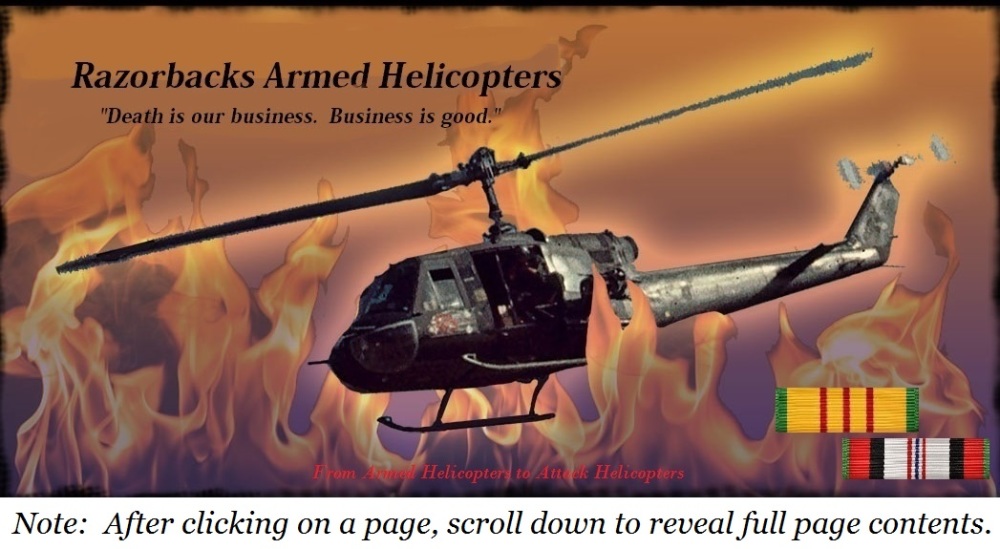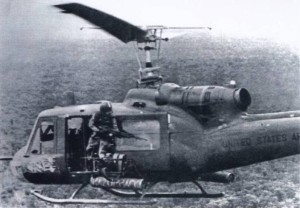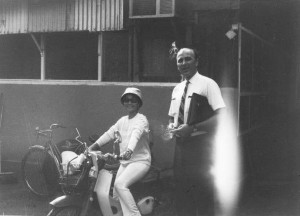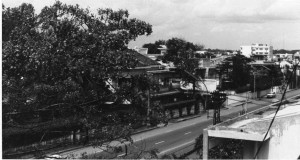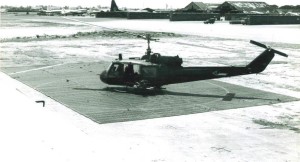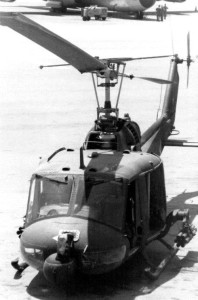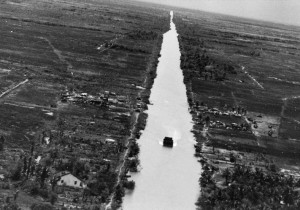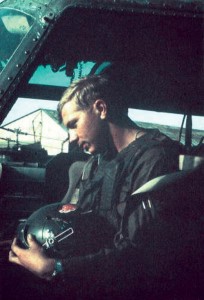This the first of two narratives by Ralph “Razorback 37” Arnesen.
The Pigs of Saigon
The Razorbacks
After 8 months of flying VIPs around what was known as III Corps I found a need to get more involved in the war. My unit, the 120th Aviation Company had a gunship platoon at Saigon Heliport and they needed pilots. I had been down and stayed at the villa on a couple of my days off and preferred the lifestyle to the one which I had at the Long Bin Headquarters. I also felt that the job I was doing was too tame.
For a start we had our own bar, a crude affair, which saw a lot of action, the type that only young men left to their own devices could aspire to, sort of a college fraternity house. Booze we got from our very own liquor salesman who rented a container where he could store beer for his other customers, the army clubs in Saigon.
Music for our parties was supplied by an Australian agent who drank lunch and did his paperwork at our bar as the noise of all the bands practicing at his place was unbearable. So we had it pretty good. The Villa was a three story affair and my own room which I shared with another officer was on the top floor overlooking the main street going into Saigon from the airport.
Cac Mang
Our aircraft were parked most of the time at the main heliport at Hotel 3, Saigon Heliport. Driving out of the heliport after coming in from flying, there were nine of us in the Jeep. We were stopped one time by either General Abrams or Mildren, these were the top 2 generals in Vietnam. He said that he would give us two days to clean up the flight line and the slum we called the villa and then he was going to inspect us personally. It took two days just to get the illegal firearms out of the villa and stored over at the liquor man, Dirty Willy’s place. He never did come and inspect us, but later the higher ups decided that they didn’t need a gunship platoon in Saigon any more.
The unit was first moved to Long Binh, the army headquarters, eventually they were moved from here too. One of the warrant officer urinating over the railing of the second story of the barracks they were billeted and hit a lieutenant coronel on the head, so they spent some time living in tents at the airfield and later sent south to the Mekong Delta to live in trailers with the navy. They got a pet pig that lived under one of the trailers. I had since moved to another unit to fly front seat Cobra.
The stand-by pad
We had three basis missions; a five minute reaction team, a lightship mission, and a sniffer mission. The five minute team of two gunships stood by at a shack between the taxi-way and the runway at Tan Son Nhut Airport. Here we had beds to rest, a television, and the snack bar was close by, across the taxiway. A second team was on 30 minute stand-by at the villa. We worked on a 24 hour on-24 hour off schedule. We flew night, day and all types of weather.
We were sometime called out at night when troops had come in contact with the Viet Cong and needed gunship support. This is hard to describe to someone who has not been there. We held off a few miles to circle and get an understanding of the situation which could take some time. We needed to identify where the friendlies were and then get some light on the situation using a flareship, usually a clapped out DC-3 flown b the Vietnamese Air Force. Coordinating all these units, some working through a translator sometimes two, was a nightmare. The possibility of shooting the wrong troops was always present. All that solved, we could start using rockets, mini-gun, or 40mm grenade. The rockets were not very accurate and had a tendency to wander off. They were not designed for a helicopter but for propeller driven airplanes in WW 2. The two mini-guns could fire straight ahead at 2400 rounds a minute each; in three second bursts. When turning the sight either way it would reach a stop and the gun not pointing into the helicopter would pick up to 4000 rounds a minute. However, these mini-guns were notorious for jamming and it was near impossible to fix them in the air, so there you sat. The door gunners with their M60 machine guns were then used to the max and were probably more effective than the rest of the equipment. The 40mm was pretty effective in certain situations, but you had to walk the rounds on to the target. The concussion was very powerful.
40mm turret on the nose & 14 2.75” rockets
Once the situation was understood we would work the weapons where we where told or until we were short of fuel and had to return.
One night it took so long to get all the information that we were low on fuel and still had not fired, the flare ship didn’t know where to drop. They finally agreed that they should drop where the helicopter rotating beacons were. The flare ship illuminated us all the way back to Saigon airport.
We went out at night with a lightship, a UH-1 with 7 C-130 landing lights arranged together, about a half-million candle power. We flew along the Cambodian border looking for sampans and troops coming into Vietnam, just like they did before TET of 1967 or 68 and attacked Saigon. We sometimes used the lightship for troops in contact but the most memorable time was when we were finished with our mission.
One of the lieutenants wanted to check out how my roommate was doing with his new girlfriend. Our room on the third floor overlooked the main road from the airport to the city centre with big French doors. John hovered level with the balcony and then hit the lights. The bed sheets flew all over the place and the pair were caught in the act. The next night it was my roommate’s turn to fly the light and pay a little visit to the villa, this time a smoke grenade came down in the courtyard. The situation got worst, the villa was shrouded in smoke every night and we all realized where it would lead, riot gas. The nightly visits finally stopped at the villa but one hotel used as a brothel got a visit from a disgruntled customer and got the gas.
One night we were flying along minding our own business and someone shot at us. We returned the favour with rockets. However, coming out of one of the runs we heard and felt a crump in the aircraft, it felt like we had been hit and decided to land at a nearby airstrip and have a look. On final approach the flying pilot said the pedals were getting stiff so we made a running landing to the runway and then everything still being OK we hovered over to the side and shut down. Using flashlights we looked the aircraft over and found nothing wrong until we looked at the transmission cowling near the rotor mast, there was a 2 inch gap! We tried to open the engine compartment but had to take the doors off to do this. Here we found the braces to the firewall ripped off and then noticed that the tail was hanging low. The crew chief looked up the hell hole, under the transmission, and just about s—t, the main beams were nearly torn in two. A classic case of fatigue just minutes from total failure. Later, we were told that the aircraft with the 40mm grenade launchers had to have about 14 pounds of lead put in the tails to get them into the weight and balance window, this might have caused an oil canning effect.
Below is a photo from the west of Saigon. The landing craft that supplied the bases on the canals were always getting hit with rocket propelled grenades, so we had to fly top cover for them while they were between bases. During one period we spent 14 hours of a 24 hour period with the rotors turning. We did 12 hours from 6 AM to 6 PM landing only to refuel, and a dawn recon the next day. You cannot imagine how boring circling over a boat doing about 6 knots is for such a long time. Even with us on top, the VC still managed to pop out of a spider hole a fire off an RPG. On one occasion we landed and picked up a soldier that had been hit while driving a boat on the canal but he died before we could get him to the hospital. By flying with the doors open, the inside of the helicopter was as if it had been sprayed with blood, including the backs of our necks and the windshield.
These were the sad times, but for the most part we had it good. Next episode I will try to remember some more war stories and then move on to civilian life.
The author as a young man in Saigon
You may want to check out the Vietnam Helicopter Pilots Association website. There are lots more war stories there.
